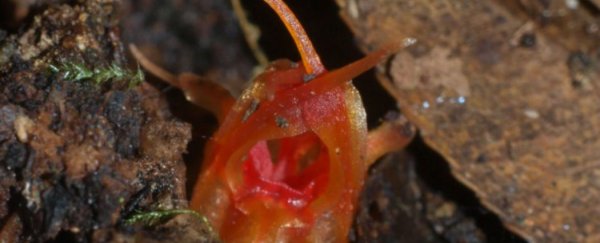A new species of plant has been found in the Blue Mountains in New South Wales, Australia, and it sure does not smell like roses. Identified by local botanist Greg Steenbeeke from the NSW Office of Environment and Heritage, this little sunset-coloured, 2-centimetre-tall flower has been named Thismia megalongensis.
"I've gone past the point where we found the plant several times a year for two decades and never knew it was there," Steenbeeke told Nicky Philips at The Sydney Morning Herald. "While it has a beautiful appearance with tiny orange flowers, this is no rose; the orange flowers give off a fungal odour when fresh and start to smell like 'rotting fish' as they decay."
T. megalongensis belongs to a genus of plants commonly known as 'fairy lanterns', because their shape and warm, glowing colour make them look like you could just pick one up and light a room with it - if you were the height of an iPhone. There are just almost 50 known species of fairy laterns around the world, found mostly in South-East Asia and South America. Back in 2003, a subterranean species was found in another area of New South Wales, and this one looks even more like a tiny lantern.
DNA testing, carried out by botanist Vincent Merckx at Leiden University in the Netherlands, revealed that T. megalongensis's closest relative is a fairy lantern native to New Zealand. "The connection suggests it has evolved in isolation for a very long time," Steenbeeke told The Sydney Morning Herald, "and genetic research on the plant's 'molecular clock' – a means of determining the time since separation from a common ancestor – suggests that these species actually separated from each other in the last 400,000 years."
And yep, this little beauty doesn't smell great. The scientists suspect that the plant has developed its unique stench by feeding off the fungi that grow alongside it on the forest floor. The strategy of smelling super-gross - as opposed to lovely, like many other species of flowering plants - is to attract a different kind of pollinator. Just like the enormous and pungent corpse flowers that smell terrible to attract scavenging flies and beetles, T. megalongensis smells like rotting flesh to attract gnats, which normally feed off algae, fungi, other insects, and blood.
Source: The Sydney Morning Herald
